It’s -39c, my breath is freezing to the collar of my jacket, there’s four foot of snow on the ground and on a nearby hill side, I can see two Golden Eagles and a Coyote fighting over a duck that’s been freshly killed. Yellowstone in the winter is a beautiful but harsh environment, not just for the wildlife, but those who go there to photograph it.
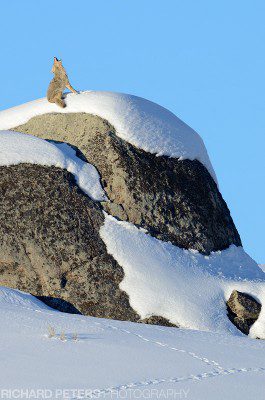
Howling Coyote, Nikon D7000 with 600 f4
Following on from Part One, this second part of my Yellowstone article concentrates on the following four days, where I captured one of my favourite shots of the trip and also got to put my cold weather clothing (and not to mention me) to the extreme test. We also had a very amusing false alarm on day six which got up the hopes of a group of about 30 photographers for the briefest of moments!
DAY THREE: MY FIRST GOOD COYOTE IMAGE
The morning was taken up pointing our lenses at the usual bison dotted around. Already, we were so used to them that where initially we had been stopping at every one we saw, now, by day three they were so common we had begun to turn our noses up unless they were in a prime position. Yes, I’m ashamed to say we had become bison snobs! But all credit to them, when it gets really cold and they are covered in frost and ice it can make for some nice dramatic images to show the harsh conditions they live in. They are hardcore so the cold weather doesn’t deter them quite as much as it does the other species. Lamar Valley was pretty quiet on our way through to Cooke City, where once again we had lunch which was very welcome given the average temperature all morning was in the -30s. On the way back though, things took a turn for the better.
We’d been told by Dale there were two big horned sheep at the far end of Lamar valley, and so far we hadn’t seen them. But that afternoon there they were, way up high on the hillside. Too far for a photo but as we stood waiting and hoping they would come down Jamie spotted a Red Fox and three coyotes off in the distance. The fox was too far out but the coyotes made for some nice environmental images framed by the surrounding trees. Don’t get me wrong, close up portraits are always welcome, but equally it’s nice to see what’s around the subject, and when the scenery is as incredible as it is here, it almost seems criminal not to include it, and so I took a couple of coyote landscapes with my 600mm, much to the bemusement of the rest of the group who I suspect thought I was crazy pointing my lens at something that was so far away.
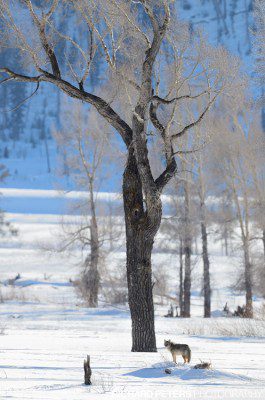
Animalscapes were often the only option
We hung around for about an hour then made our way onwards down the snow covered road until we eventually noticed our second car wasn’t behind us. So we stopped and waited. Nothing. In Yellowstone, if your second car is no longer following it means one of two things. A) They have gone down a dip at the side of the road and the car is stuck in thick snow, or B) They have spotted something worth photographing! We went back and found them at the side of the road photographing another red fox, only this time it was mousing. A fantastic event to witness and an encounter (and lesson in keeping on top of your camera settings) which I’ve already documented in a previous blog post.
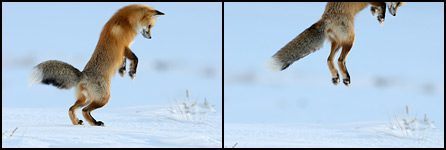
Red Fox begins to pounce…
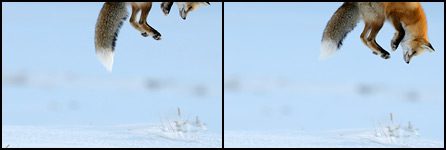
…and almost clear the frame
Capturing the image at the top of the page
We pressed on and a little later I spotted a coyote, this time quite far off again but on the top of a snow covered rock. Conveniently there was a car park just up ahead so we pulled over and whilst the others began setting up and shooting from the car park, I took the gamble of potentially missing the shot by walking back down the road to get a better angle. I knew the coyote could walk away any time but I knew the shot would be better from the vantage point where I had first spotted it further along the road. The simple reason being, from the car park the view of the coyote was mainly of it’s back and with a distant hill side cluttering the background, but from back the way we came it was side on and with a background clear of distractions. And I was certainly glad I made the effort as the scene was beautiful with a hint of the lowering afternoon sun lighting up the snow right where the coyote was sitting, and the tracks it had made where it earlier climbed the hill created a great lead in line from the bottom of the frame. Then, as I was framing up the coyote started howling. The icing on the cake. It made not only for a fantastic image and great end to the day, but also I dare say, one of my favourite coyote images of the trip. And another great example of when a small subject in the frame can work just as well as a frame filling one.
With the shot in the bag we made our way back to the hotel, our spirits far higher than the previous days snow coaching. It was safe to say we were back on track!
No wolf sightings yet.
DAY FOUR: THE COLDEST DAY
My alarm went off and I rolled over, picked up my iPhone and checked the weather. This was now part of my morning routine, when the weather app said it was currently -39 (at these temperatures, Celsius and Fahrenheit are basically the same) I did for second wonder if staying in my nice warm bed might be a more sensible option. But there’s no fun in that. I did also wonder if it might warm up as the sun rose, after all, the weather app also said the high was going to be -9f (-22c), even if the low was -18 (-27) during the day.
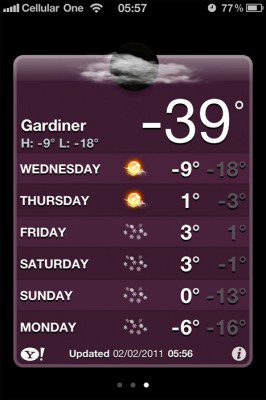
Gonna be a cold day!
The weather app lied. It never warmed up, as confirmed by our in car temperature readouts which confirmed -39 as we drove through Lamar Valley. Here’s the thing. At -39 it’s a weird kind of cold. You’d expect it to feel colder than it does, but there is no wind and it’s eerily still. You’d be forgiven at first for thinking it isn’t really that cold. But then you notice your breath freezing and turning to ice on your coat collar. Breath in deeply through your nose and you can feel a tingling sensation as the inside of your nose starts to freeze. Take your gloves off and your finger tips go numb in seconds making it all but impossible to operate the camera with any grace. Hold your blink for a half a second and you can feel your eye lashes sticking together. You get the idea, it’s cold! But, it’s also very beautiful with what at first looks like dust in the air actually being ice crystals and the snow on the ground looking like it’s been sprinkled with little diamonds. Truly stunning, and easy to forget that at these temperatures the right clothing is essential in order to not only keep warm, but stay alive! I was so glad I spent time researching what clothing to take out with me (and apologies to those of you who follow me on Twitter and remember the many, many tweets about warm weather clothing). It paid off. Because at -39 I was able to be outside, in fact, at times when I had to walk any great distance I would actually start to get hot and have to unzip things! But it wasn’t just cold outside, it was cold inside the car too, I hadn’t realised how cold though until my water bottle formed a big chunk of ice in it and started to freeze over, just sitting there on the seat next to me. Given the fact the heaters were always on inside the car should give you an idea of how little they actually warmed us up at these low temperatures.
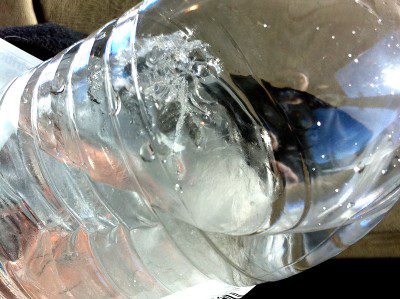
Even inside the car my water bottle turned to ice (iPhone)
We drove up and down the Lamar Valley twice and there was just nothing around. Although, we did stop at Soda Butte Creek briefly to photograph some nice frosty bison. Both the image at the top of this post, and the 5 shot panoramic you can find in Part One (why a 5 shot pano? Simply because it was easier to do that with my 600mm to get the scenery in, than it was to traverse the ice covered rocks to back to the car where the other lenses were). We did also spot a photographer way out down a stream who appeared to be photographing otters. But we figured he had done some serious ground work to get in position that early and that far from the road so we opted to carry on rather than ruin his hard work by trudging over there. The only other brief sighting was a golden eagle, our first of the trip, but certainly not the last! We stopped off for lunch in Cooke City again, then made our way back down to Lamar. And the afternoon certainly out more alive than the morning had been…
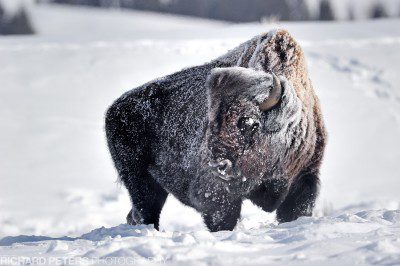
A Soda Butte Creek bison stands up to the harsh Yellowstone winter
We could see a group of photographers at a pull in further ahead. By now we had learned that anywhere there was a group of people, there was something to photograph. So we scanned the hillside in the direction they were all pointing their lenses. As we drew closer we could see some some commotion under a tree but at this point still had no idea what it was all about. We pulled over about 50 yards away as the pull over space was fully occupied by the crowd, and began to make our way down the road. As got closer two golden eagles flew our from behind a tree and came out way, in hot pursuit was another coyote. The eagles flew past us and further up the road before landing and then squabbling again. We all made an about turn and began walking back the way we had come from. By now, despite the cold weather I was sweating big time and exhausted. Remember, at these high altitudes you get tired much quicker than at sea level! I hung back as I spotted the coyote making its way back to the ridge line above, so figured rather than carrying all my gear onwards I’d try my luck where I was. It wasn’t long before the coyote was off towards the eagles again, but they flew away, one of which came past me and this time I was ready, so I managed to grab a flight shot. We spoke to the other photographers, one of whom was Charles Glatzer of shoot the light.com, who had witnessed the whole thing Basically what we had missed, was the first golden eagle plucking a duck from the water, before getting chased by the second eagle for it. Then when they landed the coyote joined in and tried to take it. That’s what all commotion was under the tree originally. We were gutted to have just missed such prime action but always nice to get a couple more coyote shots and a golden eagle in flight.
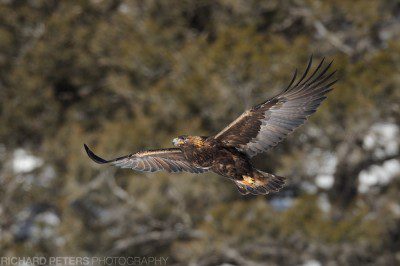
A golden eagle takes flight
As we headed back towards the hotel we stopped off at Mammoth Hot Springs and I grabbed a quick shot on my iPhone of the rear of the car before we headed back for the day. With the extreme cold conditions the back of the car was completely covered in thick ice! I was more than ready for a hot bath, I felt very tired and my head was starting to ache a little. I made a mental note that I should have drank more water today as despite the cold I got quite hot at times carrying my camera gear over ice and through deep snow.
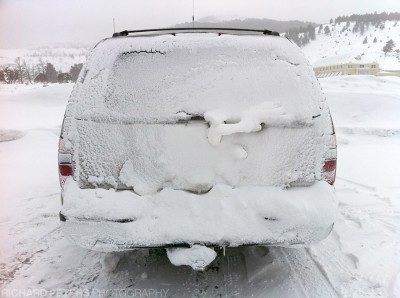
Thick ice builds up in the extreme cold (iPhone)
No wolf sightings yet.
DAY FIVE: BEST DAY OF THE TRIP, FOR EVERYONE BUT ME
My alarm went off and I felt rough. Even rolling over took a lot of effort. My head felt heavy and I had zero energy. Just walking down to get breakfast rendered me out of breath. Not good. I opted to go back to bed and rest up, as the group were heading out to Hayden Valley in the interior of the park as it was the second snow coach day. Given how exhausting and little fun the first snow coach day was I took a calculated guess that if I was going to miss a day, this would be the best one. It had been hovering around an average -37 the last few days so I decided rather than risk making myself ill for the rest of the trip, I’d rest up.
Of course, when the rest of the group returned that evening, in contrast to the first disappointing snow coach experience, they had had one of the best days of the trip so far in the stunning scenery of Hayden Valley, plus what turned out to be the best and closest Red Fox encounter of the entire trip. I was very happy for the guys, but of course was cursing under my breath that I’d missed the opportunity.
Exposing for the snow
With such a wasted day and nothing to report I thought I’d give a quick mention of how I got on exposing photos correctly with all the snow. Because cameras meter and try to expose for an average grey, images in the snow usually look a little dull. The camera thinks you are shooting a normal subject in really bright light so lowers the exposure, resulting in a dull looking image. Over exposing gets round this. Anywhere from +2/3 of a stop to sometimes +2 stops or more! I found it really depended a lot on what the colour of the subject was, and also how big in the frame they were. I spent a lot of time on Auto ISO and just used exposure compensation to get the right exposure after taking a test image, but there were times when fully manual was the way to go. The snow creates a wonderful even light on your subjects because it reflects light back up at them from below, it means that even on cloudy days you can have lovely light and it can often feel like you’re driving around in a giant soft box! But when there is a lot of cloud cover, I would find myself having to over expose more. Getting the colour of the snow can be tricky too at times, because depending on the ambient light, cloud cover or if it’s in the shade, snow can come out on camera in varying shades of cream, light grey and blue. You’ll notice not all the images in my write up have crisp white snow, and that’s because I’ve tried to reflect the lighting at the time, sometimes it was bright and sometimes it was dull and cloudy. The fox below with light blue in the image, for example, shows where there was lots of shade in the background.
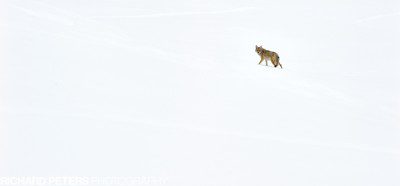
Coyote pano, not taken when I was in bed ill…
I went out for dinner with everyone in the evening and listened to the tales of the day. Seems I really did miss a good one. not only was the fox encounter superb, but the landscapes in Hayden Valley were some of the best of the trip. I was absolutely gutted.
I saw a wolf. But it was on tv.
DAY SIX: FRESH SNOW AND A FALSE ALARM
I still didn’t feel %100 but after missing out on the day before there was no way I’d be staying in bed again, plus today was the last full day for the other members of the group! And, it snowed a lot over night. Getting on for 10 inches. Despite the landscape being snow covered already, the fresh snow transformed everything again! Where there were lots of old tracks and ‘rough’ snow before, we now had either smooth clear patches of snow or nice softly rounded tracks. This gave us the advantage that now, we would be able to spot fresh tracks from old ones. The weather had also warmed up again. Gone were the -30s, they were now replaced with far milder 23f (or a blisteringly warm -5c). In fact at one point today we saw the temperature rise above freezing and up to around 41f (5c). The group made a 3/4 mile walk through the snow to scout out a past sighting of a Great Grey Owl near Blacktail Plateau, but I still didn’t have my full strength back, and given we were at around 8,000 feet above sea level, the thinner air and my lack of energy beat me and I had to turn back less than half way up the path. This turned out to be fine though as when the others returned, they were all exhausted and hadn’t spotted anything.
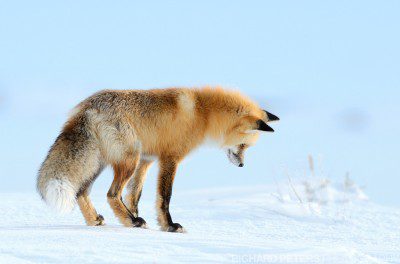
A red fox listens for mice under the deep snow
We then made our way back to the cars and on to Lamar once more where were we saw the family of five otters way off in the distance. We believe they were the very same ones we had seen the photographer with previously, but now there was a crowd of people all along the roadside watching them before they vanished through a hole in the frozen river and were gone for good. We also spotted a coyote coming down a hillside, with a nice trail behind it in the snow. It was going to cross the field and come our way, but with all the fresh snow on top of what was already there, it didn’t seem to be able to go any further in the deeper snow so it doubled back and headed up the hill again. It was taking this photo that I almost took my millionth tumble in to the deep snow. You see, when you’re standing at the roadside and setting up your tripod, you can extend one of your feet out and place it in the snow and it sits firm on the ground below. You extend the second leg to the same height, it sits firm in the ground. You extend the third leg to the same height, and the tripod lunges forward as it turns out the two foot gap between the first two legs and the last has also seen the ground underneath drop down a foot or two! It was a real Homer Simpson moment, every time it happened. And it happened a lot. And every time it did, I thought to myself ‘one of these days I’ll learn’, but I never did!
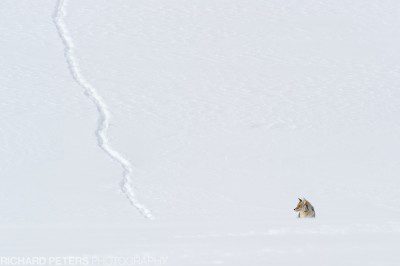
A coyote walks down the hillside, before being beaten by thick snow
Wolf…WOLF!
Making our way back down the road we spotted the now familiar tell tale sign of something happening, a large group of photographers all pointing their lenses up the hillside. Our friends the big horn sheep were back again. This time however, they were a little lower down their favourite hillside, providing us with a better angle to photograph them. We jumped out at the convenient nearby parking area and walked down to join the other 30 strong group of photographers and began snapping away at the sheep as they foraged for food by ‘pawing’ away at the snow to dig through to the plants and shrubs underneath.
A good five minutes had gone by when suddenly, a photographer in the middle of the line up shouted ‘wolf, WOLF!’. Everyone’s head looked up and there, in the distance was a large, pointy eared animal bounding through the snow and right towards us! Before I had even finished spinning my camera round a burst of about 50 shots rang out from the group of photographers before one of them shouted ‘dog, DOG!’. It was a pure comedy moment, almost like a ‘hold your fire’ being shouted out by an army sergeant at his platoon of men after someone had accidentally let a shot off in the middle of a tense stand off. A laugh erupted from the crowd as the owner of what was surely now the officially most photographed Alsatian in two seconds ever, emerged at the road side. I’m not sure if all those shots were taken so quickly because there were so many photographers there, or because we were all so desperate for our first wold sighting!
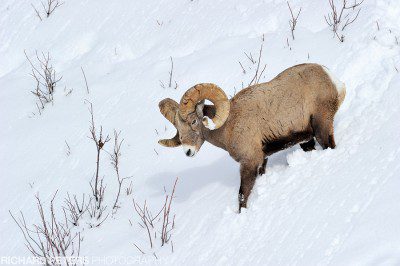
A big horn edges down the steep hill side
There wasn’t much else going on after that and Lamar Valley felt almost deserted in the afternoon, of both people and wildlife. Every photographer we had encountered so far on the trip had said this was one of the quietest winters they’ve experienced for wildlife spotting in the park in years, and they all blamed the above average snow fall. We were getting nervous that with only a few days to go, the chances of getting many more shots was decreasing rapidly – even more so for me, having missed an entire day out!
We headed back to Gardiner and spent the afternoon exploring the hills and surroundings areas outside the park where the snow was a little less thick. We encountered some prong horn antelope but all else was quiet so we went for an early dinner, where we met Walt Anderson, the inventor of the Beater Beamer who was a very nice man, and a friend of Dale. It seems Yellowstone is a small place in the winter, and all the photographers seem to know each other!
No wolf sightings yet (Alsatians don’t count)
PART THREE TO FOLLOW
The final part of my Yellowstone trilogy blog post is here on Friday. I hope you’ve enjoyed it so far. Part three is possibly the most comprehensive post of them all. With lots of images and also some facts and info about the trip to help those who might be thinking of visiting Yellowstone in the winter months for themselves
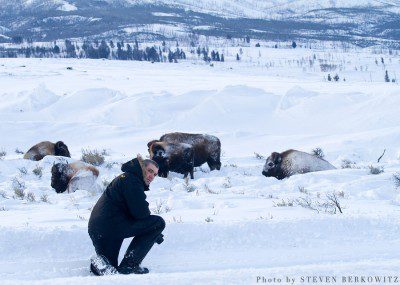
Standing in the road photographing bison, I was caught off guard








